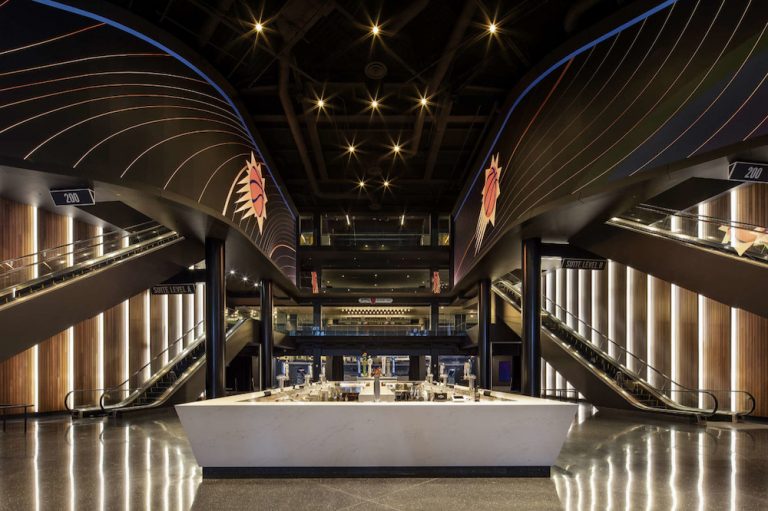If a professional sports team relocates to a new city, what are the likely economic benefits?
Professional sports teams impact a local economy in four different ways, according to the Brookings Institution:
- The creation of construction jobs to build new facilities;
- Further expansion of the local employment and increased spending in the community from fans who attend the games and those who work for the team;
- Tourists and companies attracted by the team to the host city who boost local spending and employment;
- A ‘multiplier effect’ would occur because of the increased productivity, which would also boost local income.
There are also intangible benefits in boosting a city’s image and marketability, especially among nearby communities that lack a pro team or have avid home-team fans. Michael Martin, president, and CEO of Tempe Tourism said, “What we had learned from when the NFL Cardinals moved here (Tempe, Ariz) is that there is so much market opportunity. For example, we would market football packages with tickets and hotel rooms. Our hotel partners were in places like Alburquerque, El Paso, or Las Vegas. We created packages that could drive demand from markets that didn’t have a professional sports team.”
Martin recalled that the Cardinals’ initial move to Tempe helped open up markets in Dallas. “Dallas was one team whose fans actually followed them to away games,” he said. “It opened up opportunities for us to market in places like Las Vegas and neighboring states because they didn’t – some still don’t – have professional teams, which is why they rely on Phoenix’s market since it’s close enough to drive to.”
Furthermore, sports facilities have a “significant positive effect on the value of surrounding houses and this positive effect decreases as the distance from the facilities increases,” according to a major study performed by Xia Feng and Brad Humphreys. The study suggests that sports stadiums aid in commercial real estate and may be why cities continue to bid for professional sports teams and fund stadiums.
Who has the upper hand in negotiating a relocation?
Professional sports teams relocate at the discretion of the majority owner. For example, the Phoenix Suns’ owner Robert Sarver threatened to relocate the Suns in late 2018 when the city council’s approval of the $230 million renovation proposal was delayed by a month because of difficulty rounding up the necessary votes.
Owners tend to compare their current circumstances with cities that have yet to acquire a designated professional sports team. The first factor to consider is whether the city has a suitable population for financial support or if another city offers a better market with more economic opportunities and profitable facility deals. Another consideration is whether the fanbase is increasing, holding steady, or decreasing. “We look at opportunities, which entail fanbase, revenue, fresh market, television, media, facility deals, etc.,” said Andy Bursten, who held stakes in several teams, including the MLB Texas Rangers. Finally, the team’s longevity in the current city, is there a future for the team in the current city 10-20 years down the road?
What are the typical benefits teams demand from a host city?
“Some parts would definitely be some tax advantages and some participation in either covering the full costs of the stadium or majority,” Bursten said. The team’s primary concern in negotiation is facility financing. According to several team and city negotiations, an attractive facility financing offer from the city entails five key components:
- Use of sports facilities at below-market rents
- The city’s promise to pay for the new stadium and its’ renovations
- The city’s promise to pay for a new practice facility and renovations
- The city’s commitment to an “x” amount of dollars to the stadium and practice facility’s future repairs
- The option for the team to extend or opt-out of the deal after “x” amount of years
How much will local taxpayers have to cough up? How will the city raise the necessary funds?
Negotiations finalize how a stadium or arena will be funded in the city. The funding usually arises from tax-exempt stadium bond financing, federal subsidies for professional sports facilities, and occasionally private investors alone. Subsidies exist when local and state governments issue bonds with tax-exempt interest payments. Additionally, federal taxpayers instantly subsidize (pay for) the construction of new professional sports arenas or stadiums if government officials approve the bond financing or repayment plans.
What a city pays a professional sports team to relocate is contingent upon the team, league, and the city. For example, the city of Phoenix broke down its costs for their deal with the Phoenix Suns in January of 2019. The agreement included the city of Phoenix paying $25 million to $50 million on a new practice arena and $12.5 million for the practice arena’s future maintenance. In addition, the city will cap at and front $150 million for the renovation of the now Footprint Center and another $25 million for future maintenance. The Suns will front $80 million and all additional costs that overrun.
Another example would be the 16 stadiums the NFL successfully opened from 2000 to 2020. According to data compiled by ESPN, 14 of those 16 stadiums received $5 billion in public funding, while the remaining two received total funding from private investors. Additionally, the Green Bay Packers and Chicago Bears renovated their stadiums with the help of $557 million from public contributions, and the Kansas City Chiefs’ Arrowhead stadium received $262 million to renovate in 2011. Thus, these three stadiums alone accumulated $820 million in subsidies (see charts).
********
To illustrate the cost and financing of NFL stadiums, excluding any maintenance costs, the chart below breaks down the public vs. private contributions in percentages. The second chart displays the value of the major leagues’ gross revenue and net worth for an idea of the economic value a professional sports team can bring to a city.
NFL Stadium Financing
| Stadium Name | State | City | Cost | Public | Private | Team |
|---|---|---|---|---|---|---|
| NRG STADIUM | TX | Houston | $449,000,000.00 | 43% | 57% | Houston Texans |
| GILLETTE STADIUM | MA | Foxboro | $325,000,000.00 | 0 | 100% | New England Patriots |
| NISSAN STADIUM | TN | Nashville | $290,000,000.00 | 70.90% | 29.10% | Tennessee Titans |
| STUBHUB CENTER | CA | Carson | $150,000,000.00 | 0% | 100% | Los Angeles Chargers |
| PAUL BROWN STADIUM | OH | Cincinnati | $450,000,000.00 | 94.40% | 5.60% | Cincinnati Bengals |
| SPORTS AUTHORITY FIELD | CO | Denver | $364,000,000.00 | 68.40% | 31.60% | Denver Broncos |
| HEINZ FIELD | PA | Pittsburgh | $2,810,000,000.00 | 61.10% | 38.90% | Pittsburgh Steelers |
| M&T BANK STADIUM | MD | Baltimore | $220,000,000.00 | 90% | 10% | Baltimore Ravens |
| METLIFE STADIUM | NJ | East Rutherford | $1,600,000,000.00 | 0 | 100% | New York Jets |
| FIRSTENERGY STADIUM | OH | Cleveland | $290,000,000.00 | 74.70% | 25.30% | Cleveland Browns |
| NEW ERA FIELD | NY | Buffalo | $22,000,000.00 | 100% | 0 | Buffalo Bills |
| LUCAS OIL STADIUM | IN | Indianapolis | $720,000,000.00 | 85% | 15% | Indianapolis Colts |
| HARD ROCK STADIUM | FL | Miami Gardens | $115,000,000.00 | 90% | 10% | Miami Dolphins |
| EVERBANK FIELD | FL | Jacksonville | $121,000,000.00 | 85.80% | 14.20% | Jacksonville Jaguars |
| ARROWHEAD STADIUM | MO | Kansas City | $43,000,000.00 | 100% | 0 | Kansas City Chiefs |
| OAKLAND COLISEUM | CA | Oakland | $200,000,000.00 | 100% | 0 | Oakland Raiders |
| FEDEX FIELD | MD | Landover | $250,000,000.00 | 28% | 72% | Washington Redskins |
| SOLDIER FIELD | IL | Chicago | $600,000,000.00 | 65.90% | 34.10% | Chicago Bears |
| US BANK STADIUM | MN | Minneapolis | $1,100,000,000.00 | 45.20% | 54% | Minnesota Vikings |
| UNITED AIRLINES MEMORIAL COLISEUM | CA | Los Angeles | $954,872.00 | 100% | 0 | Los Angeles Rams |
| CENTURYLINK FIELD | WA | Seattle | $360,000,000.00 | 69.80% | 30.20% | Seattle Seahawks |
| LINCOLN FINANCIAL FIELD | PA | Philadelphia | $518,000,000.00 | 36.30% | 63.70% | Philadelphia Eagles |
| MERCEDES-BENZ SUPERDOME | LA | New Orleans | $134,000,000.00 | 100% | 0 | New Orleans Saints |
| FORD FIELD | MI | Detroit | $5,000,000,000.00 | 51% | 49% | Detroit Lions |
| AT&T STADIUM | TX | Arlington | $1,000,000,000.00 | 32.50% | 67.50% | Dallas Cowboys |
| UNIVERSITY OF PHOENIX STADIUM | AZ | Glendale | $455,000,000.00 | 62.70% | 37.30% | Arizona Cardinals |
| METLIFE STADIUM | NJ | East Rutherford | $1,600,000,000.00 | 0 | 100% | New York Giants |
| BANK OF AMERICA STADIUM | NC | Charlotte | $242,000,000.00 | 23% | 77% | Carolina Panthers |
| LEVI’S STADIUM | CA | Santa Clara | $1,300,000,000.00 | 12% | 88% | San Francisco 49ers |
| MERCEDES-BENZ STADIUM | GA | Atlanta | $1,500,000,000.00 | 30% | 70% | Atlanta Falcons |
| RAYMOND JAMES STADIUM | FL | Tampa | $194,000,000.00 | 100% | 0 | Tampa Bay Buccaneers |
| LAMBEAU FIELD | WI | Green Bay | $295,000,000.00 | 57.30% | 42.70% | Green Bay Packers |
Economic Value of the Major Leagues
| League | Gross Revenue ($ billions) | Net Worth ($ billions) |
|---|---|---|
| MLB | $2.79 | $6.55 |
| NHL | $1.82 | $3.75 |
| NFL | $3.51 | $12.80 |
| NBA | $2.10 | $6.01 |
********
What are the potential downsides for a host city?
Michael Leed, a sports economist at Temple University, said that sports stadiums have only a marginal impact on a city’s economy. “If every sports team in Chicago were to suddenly disappear, the impact on the Chicago economy would be a fraction of 1 percent,” Leed said. “A baseball team has about the same impact on a community as a midsize department store.” Considering the MLB has at least 80 home games, and its economic impact is minimal, what would be the impact of other major leagues? The NFL has about eight home games, the NBA and NHL have around 40. So, aside from a direct financial impact a team or stadium may bring, what are some finances that economists or cities overlook when considering public funding for a sports stadium?
According to research from the Federal Reserve Bank of St. Louis, opportunity costs – essentially what is given up to acquire something else – are overlooked when considering the impact of stadiums. If consumers were not spending on sporting events, they would likely be spending on museums, movies, concerts, theaters, restaurants, etc. Therefore, a new stadium may not bring in new spending but divert spending from other venues.
Additionally, with the promise of million-dollar players coming into town with a new sports team, there is an expectation that the players will aid in local economic growth. However, most players leave in the off-season taking their spending habits with them and as Holy Cross University economics professor Victor Matheson noted, “if you go to a local bar, that’s probably locally owned, and servers and bartenders are spending it locally, that causes this ripple effect that doesn’t happen in sports.”
Adverse effects may also occur when professional sports teams choose to leave the city. “If you lose a sports team, then it can be detrimental because the local businesses may have been reliant on the team generating foot traffic during game days,” Martin said. “We saw that happen here in Tempe when the Cardinals moved to Glendale.”
Some questions for journalists to consider are:
- Would the revenue generated from a professional sports team stay within the local community? If so, how much?
- Is the expected revenue used to promote local job growth or outsourced?
- With the promise of more employment opportunities, are the jobs temporary, contracted, or permanent?
- Would the public funds used to build the stadium result in the promised economic development?
- How many players reinvest in the local community?
- With half of the season being away games, how much tangible impact do the players have in the community?
- Would popular games create an “over-crowding” dilemma? If so, how would that affect local neighborhoods and non-sports enthusiasts? Traffic?
- Would the influx in community activity to celebrate or watch the games create more raucous amongst the fans? If so, would this instigate juvenile behavior (bar fights, property damage, bullying, etc.)?










